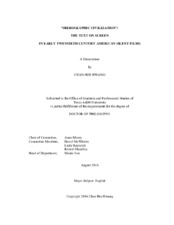| dc.description.abstract | This dissertation investigates the significance of onscreen textual elements— intertitles, and inserts and props with text on them—during the silent film era by defining them as the contact zone between text and image. I examine how discourse on film during the silent film era described and prescribed text on the screen and analyze how silent films by Cecil B. DeMille, D. W. Griffith, and Buster Keaton use textual elements between and within visual images as a site in which conflicting ideas on the status of film and the limitations/possibilities of the film medium converge.
Focusing upon the hieroglyph as one of the main metaphors used in silent film discourse, Chapter Two and Three explore the heated contest between text and image during the silent film era. Vachel Lindsay, among others, valorizes the silent film as a universal language and states the hieroglyph as a key term to capture the gist of film as image-text, making the connection between silent film and the American Renaissance.
Interacting with its contemporary hieroglyph discourse, DeMille’s The Ten
Commandments explores the hybridity of the hieroglyph by building up the dichotomy between image and text and criticizes the violence embedded in the process of writing, celebrating the filmic medium. The next two chapters investigate the cases of Griffith and Keaton as two extremes concerning the use of onscreen text. Griffith, with his anxiety regarding the lowly status of film in the early twentieth century, actively and heavily uses intertitles that emulate the voice of the author and invoke textual authority, ultimately creating a book onscreen and inviting his audience to read the film. Griffith freezes the moving image and permits the non-diegetic written text to overwhelm the diegetic image on screen in his attempt to create bookness onscreen. Keaton is located on the opposite side of Griffith in his challenging attitude to the text and his endeavor to communicate with nonverbal means. Keaton, through the mastery of his body as the subject of the narrative and means of narration, minimizes the intervention of the intertitle and, moreover, resists the influence of language stylistically and thematically. | en |


